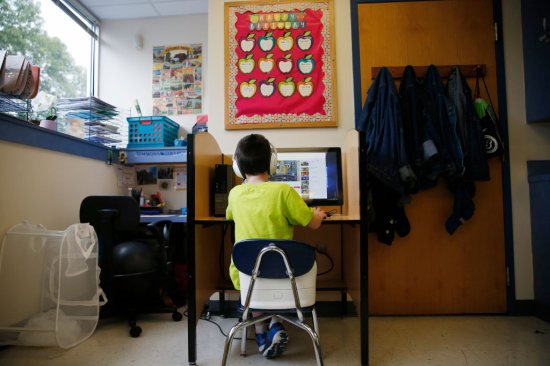
The AI revolution gives us unprecedented opportunity to reshape education, writes Dr. Timothy Shriver, Special Olympics chairman.
As summer winds down and the familiar hum of school buses returns to our neighborhoods, millions of American students are gearing up for another year of learning. But as we stand on the cusp of an artificial intelligence (AI) revolution, this annual ritual is about to face a seismic shift—especially for students with intellectual and developmental disabilities (IDD).
The decisions that school leaders make in the next academic year are likely to determine whether this technological wave creates more inclusive learning environments, or exacerbates existing disparities. A recent study from the Special Olympics Global Center for Inclusion in Education reveals a complex landscape of attitudes towards AI in education and a fear of leaving students with IDD behind.
[time-brightcove not-tgx=”true”]The study found the majority of educators (64%) and parents (77%) of students with IDD view AI as a potentially powerful mechanism to promote more inclusive learning. AI will never replace the centrality of genuine human connection in teaching, the essential element for our community to flourish in the classroom or on the playing field. But contrary to the alarms that many are raising about AI in schools, our research demonstrated significant optimism about the technology. Those who work most closely with young people with ID see great potential in AI’s ability to simplify information—including lectures and curricula—making it more accessible to students with disabilities. Imagine the adaptive learning systems that can provide each student with an educational approach tailored to their unique needs.
But despite teachers’ confidence in AI’s potential for students with IDD, our research also shows that their fears about potential negative impacts on the general student population overshadow their enthusiasm for its role as a learning aid. Specifically, the majority of teachers (78%) express concern that the use of AI in schools might lead to a decrease in human interaction in schools, with 65% also worried about AI use potentially reducing students’ ability to practice empathy.
How do we overcome those fears? We found that teachers who have used AI are much more likely to think it can make education more inclusive, inspiring more creative thinking about how it can support their students with IDD. These educators are less prone to generalizing concerns that AI will negatively impact the classroom experience for the broader student population. Such findings demonstrate the importance of comprehensive teacher training on AI platforms. By familiarizing educators with AI tools, we can bridge the gap between potential and application, fostering more inclusive learning environments for all students.
But ultimately, educators’ experience with the tools alone is insufficient. Our study reveals concerns among teachers (72%) and parents (63%) that AI models themselves have not been trained on data provided by persons with IDD, and therefore do not accurately reflect their capabilities and contributions.
Thus, people with IDD must have a seat at the table when discussing the responsible use of AI in education. For example, Microsoft acknowledges that “humanity traverses a broad neural spectrum” and has expanded design approaches that once narrowly focused on physical disabilities to include differences in cognitive issues and learning styles. They have also acknowledged the importance of diversifying the teams that build and test AI, as well as making a conscious effort to identify bias in the data sets used to train AI systems. Greater attention to and adoption of inclusive design principles for educational technology will translate into more inclusive learning environments.
A failure to listen to people with IDD will result in 3% of the population being locked out of the most revolutionary technology since the advent of the personal computer. That must not happen.
Making AI tools inclusive requires a collaborative effort among teachers, parents, and most importantly, tech companies. Special Olympics is calling on the companies that develop AI systems to convene experts in technology and inclusive education to initiate meaningful dialogues with the IDD community to ensure their needs and perspectives are considered in product development.

Many Special Olympics athletes are already using AI tools independently to help ensure they are understanding the nuances of conversations, meetings and lectures, as well as to help organize ever more complex schedules and training regimes. Education leaders can utilize AI to help identify when their school climate is sliding into toxicity, allowing for more targeted early interventions to address isolation and bullying. Young people with ID have been on the frontlines of this fight, working to create a climate of justice and joy where social inclusion is the norm. They have reflected deeply on AI and what it means for their future; we only need to ask them to share their thoughts.
As pencils are sharpened and backpacks are filled, let’s also sharpen our resolve to make this school year a turning point for inclusive education. If used responsibly, AI can help to tear down the physical walls at segregated schools, as well as the invisible barriers that separate children of different abilities within the same classroom. We believe that AI can get us there.
Our research illuminates both the promise and the challenges of AI in supporting students with IDD. But it also shows us the way forward: through teacher training, community involvement, and a commitment to inclusive design. As we step into this new school year, we have before us an unprecedented opportunity to reshape education, to close gaps, and to unlock the full potential of every student.
The school of tomorrow is being built today—let’s make sure it has room for everyone.
TIME Ideas hosts the world's leading voices, providing commentary on events in news, society, and culture. We welcome outside contributions. Opinions expressed do not necessarily reflect the views of TIME editors.